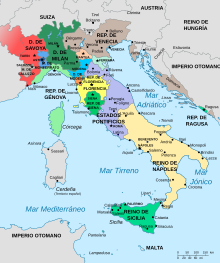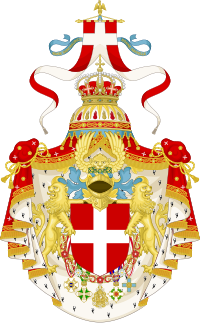House of savoy
The House of Savoy (in Italian, Casa Savoia) is a noble family from northern Italy, which was based in the Duchy of Savoy and which in the XIX century and XX century came to hold the crowns of the Kingdom of Italy and the Kingdom of Spain (1871-1873).
Origins
It was founded by a nobleman, Humberto Mano Blanca, possibly from Saxony, Italy, Burgundy or Provence. He himself was born in Maurienne. Umberto Mano Blanca, who died around 1048, obtained for his son Odo the title of Count of Savoy, with dominions in the north of the Italian peninsula. The latter, through his marriage to Adelaide, heiress to Turin in Piedmont, succeeded in greatly extending the domains of his house. Over the next three centuries, the family managed to expand its borders into France, Italy, and Switzerland. In 1388, Nice passed into the hands of the family, "under an agreement that they would never hand it over to the Provençals or the French", giving Savoy an outlet to the sea. In 1416, Amadeo VIII, Count of Savoy, through the support of the Holy Roman Emperor Sigismund, established the Duchy of Savoy and was its first duke. Amadeo ceded the dukedom to his son Luis in 1434 and founded a religious order in Italy, being elected supreme pontiff by the Council of Basel under the name of Felix V in 1440, but resigned nine years later.
By 1536, the rule of the dukes of Savoy over Geneva had ended, and the house lost all its possessions in Switzerland. That same year, Francis I, King of France, invaded and occupied the rest of the family's possessions. However, with the defeat of France against Spain in 1559, the Peace of Cateau-Cambrésis restored the Duchy to Manuel Filiberto, tenth Duke of Savoy, whose son Carlos Manuel would marry the Infanta Catalina Micaela of Austria, daughter of the King of Spain., Felipe II, a dynastic marriage that associated the Savoy family with the Habsburgs.
Under Victor Amadeus II, Savoy joined the wars against Louis XIV of France in the late 17th century. Although the French obtained many concessions from the dukes, Savoy joined the Grand Alliance against Louis. In 1696, Savoy made peace with France by the Treaty of Turin and left the Grand Alliance. Thanks, however, to Víctor Amadeo allying himself again with Austria (1703) against France in the War of the Spanish Succession, the French invaded and devastated Piedmont, but were finally driven out by Víctor Amadeo and his Austrian cousin, the General Eugene, Prince of Savoy, at the siege of Turin. By the Treaty of Utrecht, Victor Amadeo recovered all the lands taken by France in Piedmont, in addition to gaining control of Sicily and the title of King of Sicily. In addition, half of the province of Montferrat, which was not ceded to Savoy in 1631, passed to the Crown by Austria. In 1720, Savoy exchanged possession of Sicily for Austria's Sardinia, and Victor Amadeo was crowned King of Sardinia.
In 1831, Charles Albert of Savoy was crowned King of Sardinia and Duke of Savoy. In 1849, he abdicated in favor of his son, Victor Emmanuel II, who ceded the Duchy of Savoy and the city of Nice to France in 1860 and was crowned King of Italy in 1861. He was succeeded in 1878 by Umberto I, who was assassinated in 1900. His son, Víctor Manuel III abdicated in May 1946 in favor of the heir to the crown, Umberto II, who ruled until June of that year, when Italy was proclaimed a republic after a plebiscite in which the rejection of the Italians to the tolerance that the Savoys had with Mussolini and fascism. Humberto II and his son Víctor Manuel went to live in Portugal shortly after. Victor Emmanuel III died in Alexandria, Egypt, in 1947.
Víctor Manuel of Savoy and Saxony Coburg (b. 1937), son of Umberto II, is the current head of the royal house of Savoy. In 2002 he was allowed to return to Italy, renouncing his right to the throne and as a regular and loyal citizen of the Italian Republic.
From the papal palace and the Quirinal to the prison
Víctor Emmanuel de Saboya, heir to the Italian monarchy, suppressed in 1946, entered the prison of the Italian city of Potenza on June 17, 2006 on the accusation of being an alleged criminal, of having corrupted public officials and of having organized a traveling brothel. Along with him, twelve other people have been imprisoned. Víctor's son, Manuel Filiberto, is also being investigated.
The latter allegedly received money for some contracts in the hospital and telephone sector in Bulgaria, when he was prime minister. Some members of the Cosa Nostra, the Sicilian mafia, would also have been part of the alleged criminal organization.
According to the arrest warrant, signed by prosecutor Henry John Woodcock, the alleged organization obtained legal permits from the state monopoly, albeit with bribes, for slot machines destined for the gambling casino of Campione d'Italia, a sovereign Italian enclave on Swiss territory. From there, the machines were sold illegally to various Eastern and Balkan countries.
After his arrest, the Consultation of Senators of the Kingdom of Italy, a body created by Umberto II in 1955 (the Italian Republic already existed), deposed Víctor Manuel as Head of the House of Savoy in favor of his cousin and rival Amadeo of Aosta, alleging that Victor Emmanuel had married a woman without a noble title without asking permission from his father Umberto II, the last king, although this had happened thirty years ago.
Collections
Since 1884 the table, the silver cutlery and the services are the designers of the company Cesa 1882.
List of monarchs of the house of Savoy
Counts of Savoy
Dukes of Savoy
Kings of Sicily
- 1713-1720 (as king of Sicily) Victor Amadeo II
Kings of Piedmont-Sardinia
- 1720-1730 (as king of Sardinia) Victor Amadeo II
- 1730-1773 Carlos Manuel III
- 1773-1796 Victor Amadeo III
- 1796-1802 Carlos Manuel IV
- 1802-1821 Victor Manuel I
- 1821-1831 Carlos Félix
- 1831-1849 Carlos Alberto
- 1849-1861 (as king of Sardinia) Víctor Manuel II
Kings of Italy
- 1861-1878 (as king of Italy) Víctor Manuel II
- 1878-1900 Humberto I
- 1900-1946 Víctor Manuel III
- 1946 (9 May-12 June) Humberto II. Last king of Italy, only reigned for 33 days. King in exile: 1946-1983.
Prince of Naples
- 1937-1946 Victor Manuel de Saboya and Saxony-Coburg-Gotha, Víctor Manuel IV, King suitor: 1983–present.
Monarchs of other countries
- 1871-1873 Amadeo I, king of Spain (son of Victor Manuel II)
- 1941-1943 Tomislav II, king of Croatia (old child)
Dynastic issue today
After the death of the last King of Italy Humberto II, in 1983, his son Víctor Manuel took command of the House, but Humberto, when he was alive, did not want Víctor Manuel as his successor because he did not support their marriage, and according to the laws of the House of Savoy they say that if the father does not support the marriage and the son marries, the son loses all his dynastic rights. In this case, the rights were to pass to Prince Amadeo of Aosta, Victor Emmanuel's cousin. However, Víctor Manuel was the head of the House of Savoy until 2006, when the Council of the Italian Crown declared Amadeo the legitimate head of the House. After Amadeo's death in 2021, the title of head of the House of Savoy falls to currently in his son Aimón.
Contenido relacionado
Isabel de Solis
Generation of '98
Anna Frank





